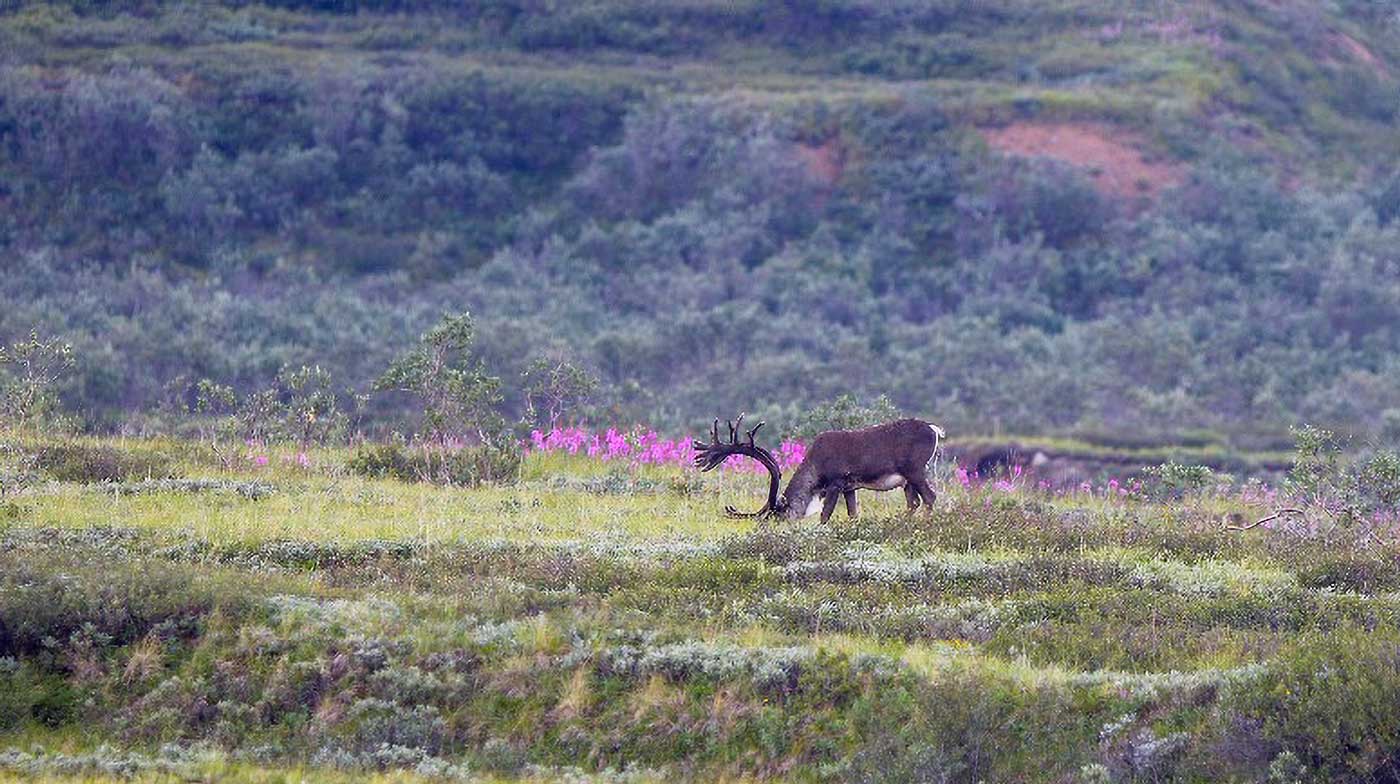
Alaska
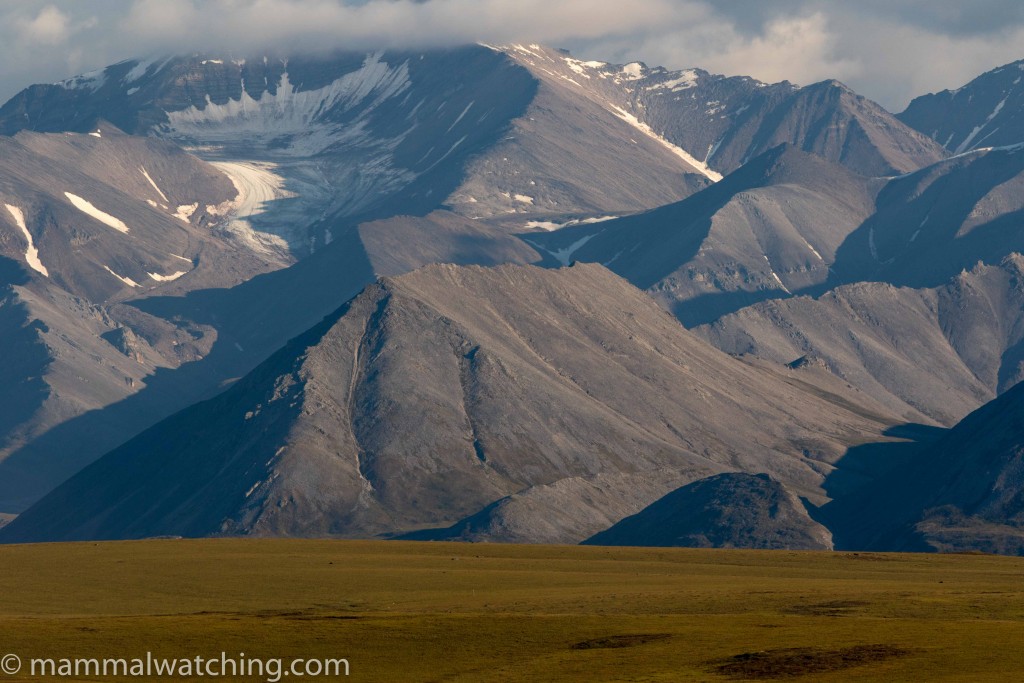
Brooke’s Range, north Dalton Highway
In May 2006 I spent just 24 hours in Alaska and travelled on the ferry from Haines to Skagway during a trip around the Canadian Yukon. I saw a few Harbour Seals, but not the suposedly common Dall’s Porpoise nor the Mountain Goats that are often seen as the ship comes in to Skagway.
I returned for 5 days in July 2015, with my two kids. Our – OK let’s be honest my – targets were Alaska Marmot and Collared Pika, with Lynx a half-hoped for long-shot
We flew into Anchorage and drove 6 hours north to Fairbanks for the night, before heading up the Dalton Highway the next morning. As others have mentioned, the Dalton Highway, at least in July, is far less rugged a road than many of the brochures would have you believe. A lot of the first 200 miles is paved, and other than a very occasional piece of grit hitting the windshield from a passing truck there was little to be concerned about. Nevertheless, most (all I think) of the major car rental agencies forbid you from taking their cars up the road, so I decided to hire a vehicle for 48 hours from Arctic Outfitters in Fairbanks. It was not cheap, but it was cheaper than the competition and the second spare tire, CB radio and peace of mind was sort of worth it.
The Dalton Highway
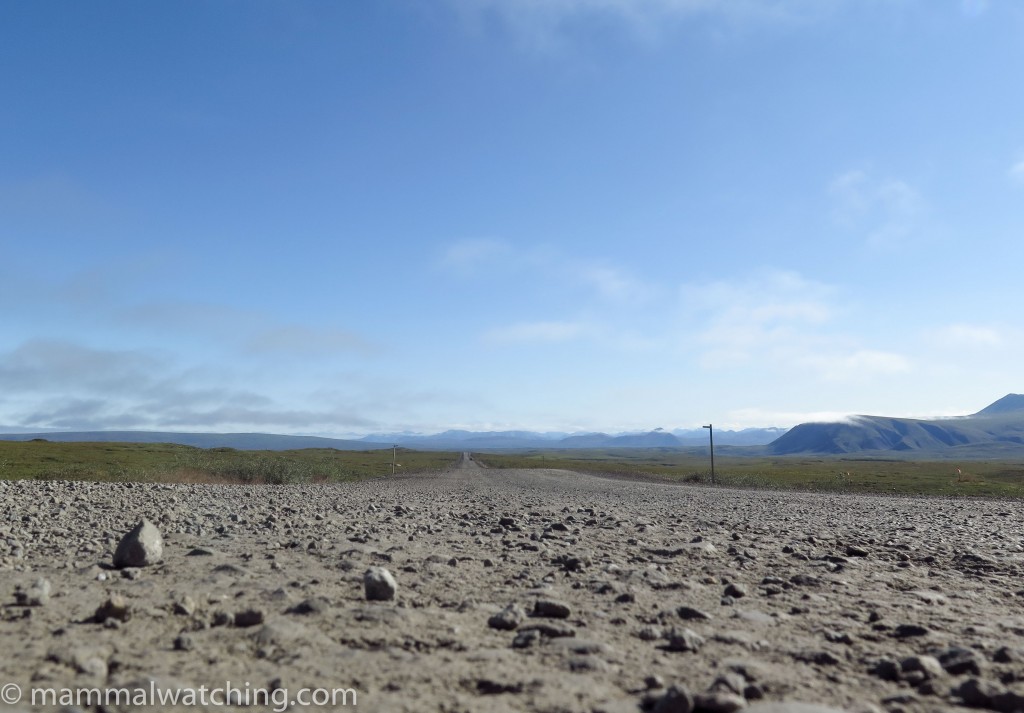
The Dalton Highway
It took nearly 8 hours’ driving from Fairbanks to get to the start of Alaskan Marmot habitat, just after Atigun Pass and the peak of the range. The drive up was pretty but the only mammal of note was a distant Black Bear. I’d researched Marmota broweri sites beforehand and got some great help from Aren Gunderson at the University of Alaska Museum. Aren is one of – if not the – leading expert on this species (see his work here). It was Aren who helped Dave Robichaud see this species during his 2006 Marmothon.
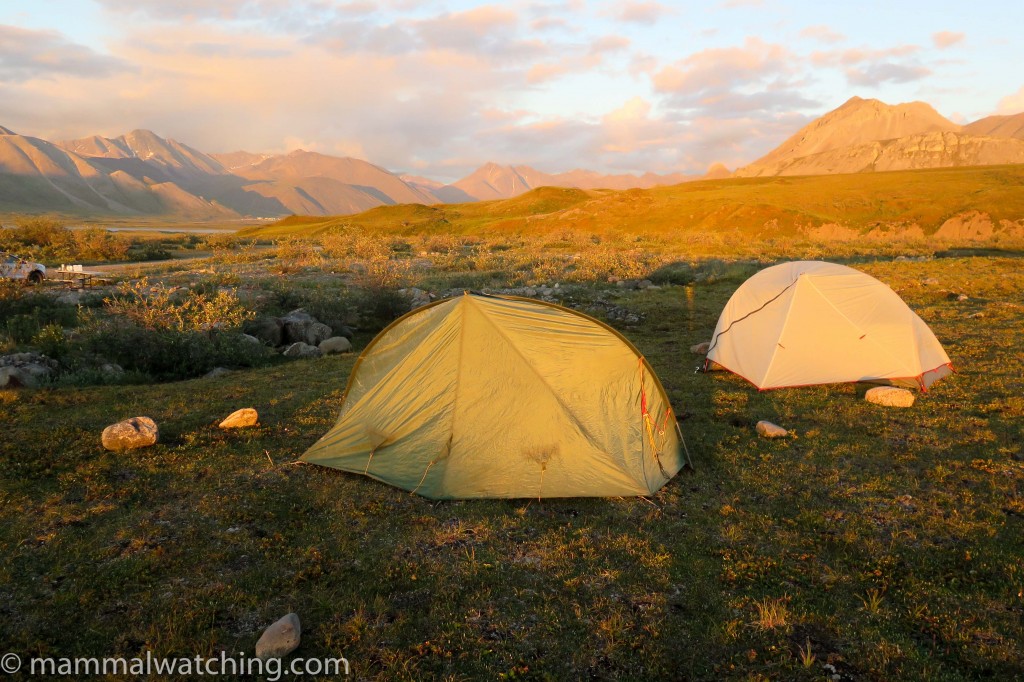
Midnight camping at Galbraith Lake, Brooke’s Range
Aren recommended checking two sites for easy marmot spotting: a small gravel pit just north east of Galbraith Lake, and another site 10 miles up the road. I chose the latter, stopping first to look at the site Vladimir Dinets and John Fox scored at in 2010, on the east side of the road at mile 259. I got a distant look at an Alaskan Marmot here, but got much longer and better looks at the colony that Aren had recommended, near mile marker 283, a mile or two south of Toolik Field Station.
Directions are as follows. As you travel north up the Dalton Highway, look for a pipeline service track off to the right (east). These side roads are infrequent and I think this is the only one between mile 280 and the Toolik turn-off. The road is gated, so you need to leave your car, walk under the gate and up the hill under the pipeline. The marmots are on the low rocky hill in front of you, but access is easiest if you follow the road as it turns to the north and approach the hill from the northern slope, rather than cut across the boggy tundra in front of you. I found several Marmots easily here at about 9 p.m. Well worth the cold silence from my daughter when I got back to the car, who had refused to set food on the mosquito ridden tundra, but was unimpressed at being left to the mercy of the Grizzlies. Oh well.
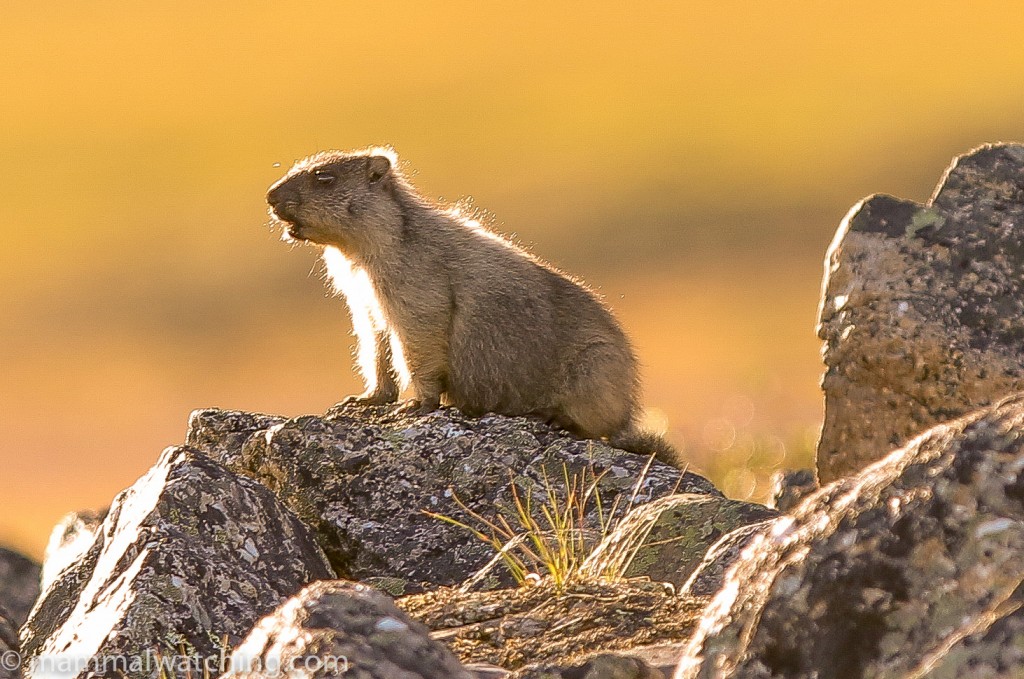
Alaska Marmot, Marmota broweri
Walking back to the car I saw a family of three Red Foxes playing in the long grass, looking lovely in the soft evening light. The soft evening light lasted until 3 a.m. by which time it was blazing bright again.
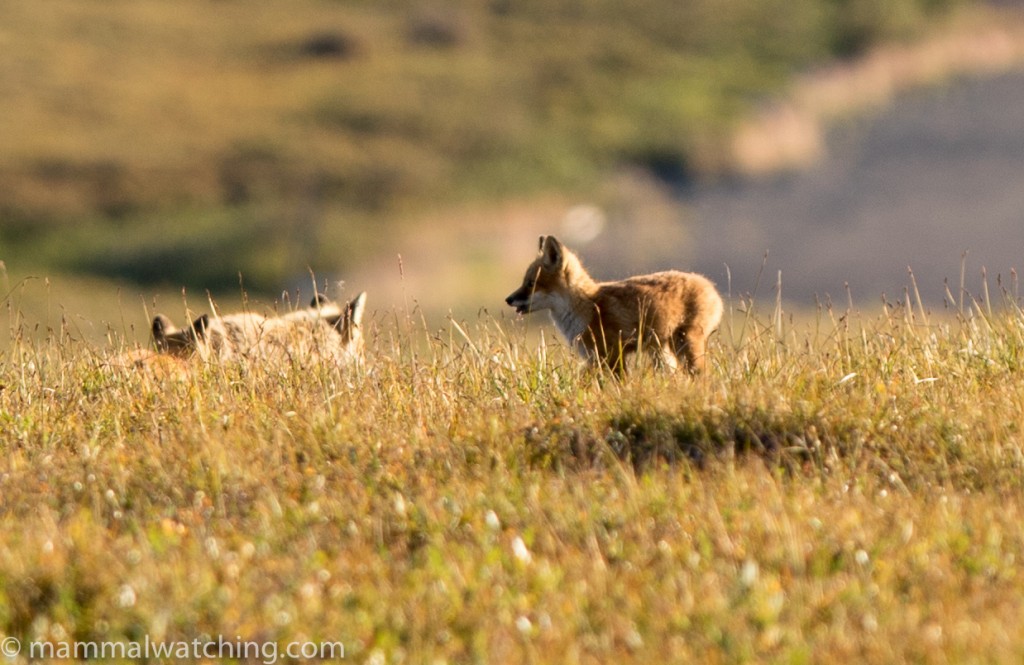
Red Foxes, Vulpes vulpes
We camped the night at Galbraith Lake, where there were a few Arctic Ground Squirrels, and continued up to mile 301 the next morning to look for Dall’s Sheep on the north face of Slope Mountain. We saw 4 distant animals.
I’d wanted to drive on another 40 miles to look for Musk Ox around the Happy Valley area (a regular spot for them), but realised I would not have had enough gas to have gotten back to Coldfoot, the first fuel stop heading south, and didn’t have the time nor desire to drive 2 hours north to Deadhorse to get fuel only to turn around again. So we drove back to Fairbanks, dropped off the car at about 8 p.m. and drove another 2 hours south to spend the night near the entrance to Denali National Park.
Denali National Park
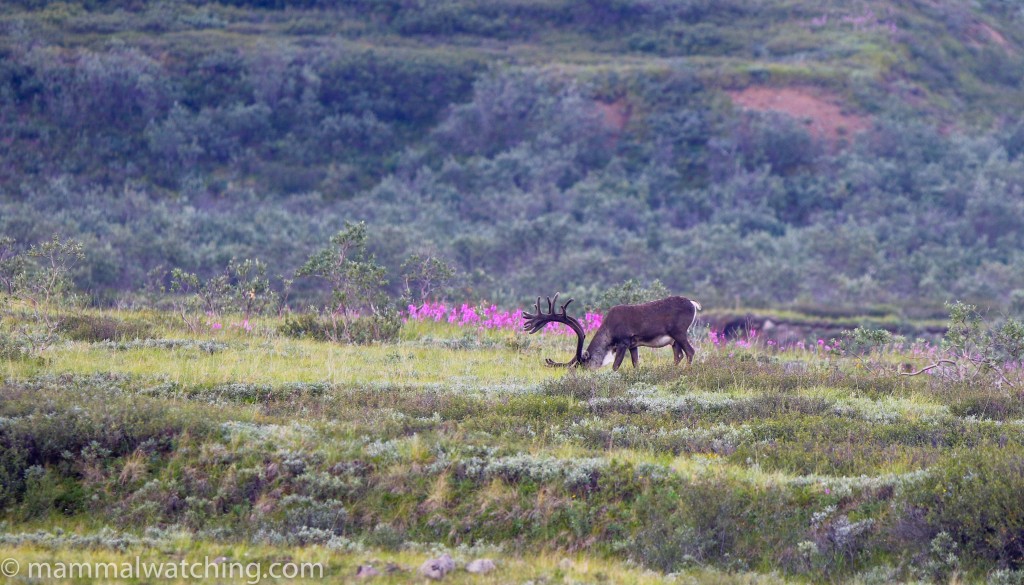
Bull Caribou, Rangifer tarandus, Denali National Park.
I had wanted to visit Denali National Park for as long as I have been interested in mammals. I wasn’t disappointed. The wildlife viewing is exceptional. And even though it was peak season, the compulsory use of park buses along most of the only road through the park meant the park didn’t feel too crowded.
First, a little on the logistics. During the high season, June – August, visitors to the park are generally not allowed to take their own vehicles past the Savage River campsite at mile 12 of the park highway. An exception is made for those camping at some (not all) of the campsites further into the park.
I booked a space at Teklanika River Campground, which is the furthest campground one is allowed to drive to. If you are staying at Wonder Lake for example, you have no choice but to take the bus. Even when you are camping, you don’t have carte blanche to drive up and down the road: after checking-in at the visitor centre you are given two permits to cover one trip up and one down the road. The checkpoint was shut at midnight when I eventually arrived at camp, so no one checked my permit on the way in, but the return ticket was collected when I left the next morning.
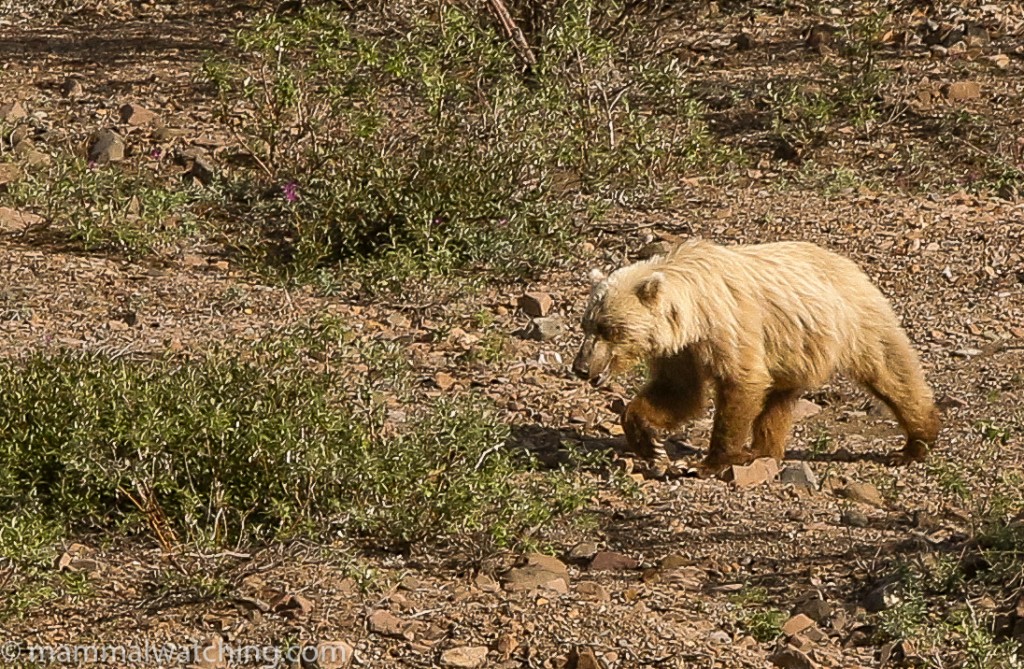
Grizzly, Urus arctos horribilis
Shuttle and tour buses traverse different bits of the park road all day and you can get off one, walk a bit or a lot, and then hitch a ride on another if there is space. We had pre-booked onto the last shuttle bus that day that drove to the end of the road (Wonder Lake) and back. It left the visitor centre at about 10.30 a.m. returning around 9 p.m.
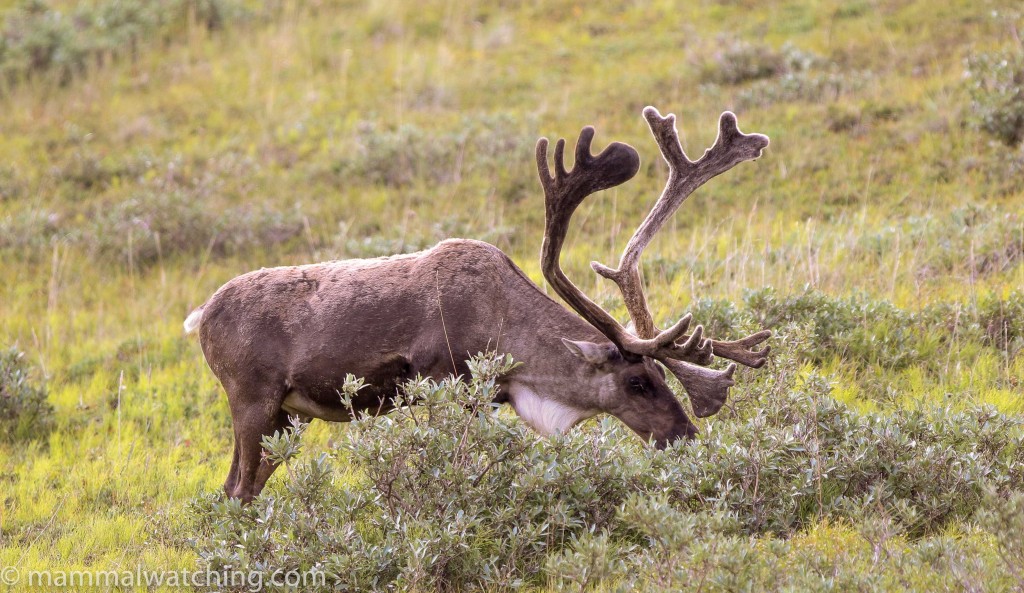
Caribou, Rangifer tarandus
We didn’t see many mammals until we passed Teklanika River, after which we saw our first Grizzly, the first of at least ten that day. Other mammals included a big Bull Moose, several Caribou, some photogenic Dall’s Sheep and plenty of Arctic Ground Squirrels and Hoary Marmots, especially at the Eielson Visitor Centre, plus a Red Squirrel at Wonder Lake. There were – not surprisingly – more animals moving around during the late afternoon on our return trip.
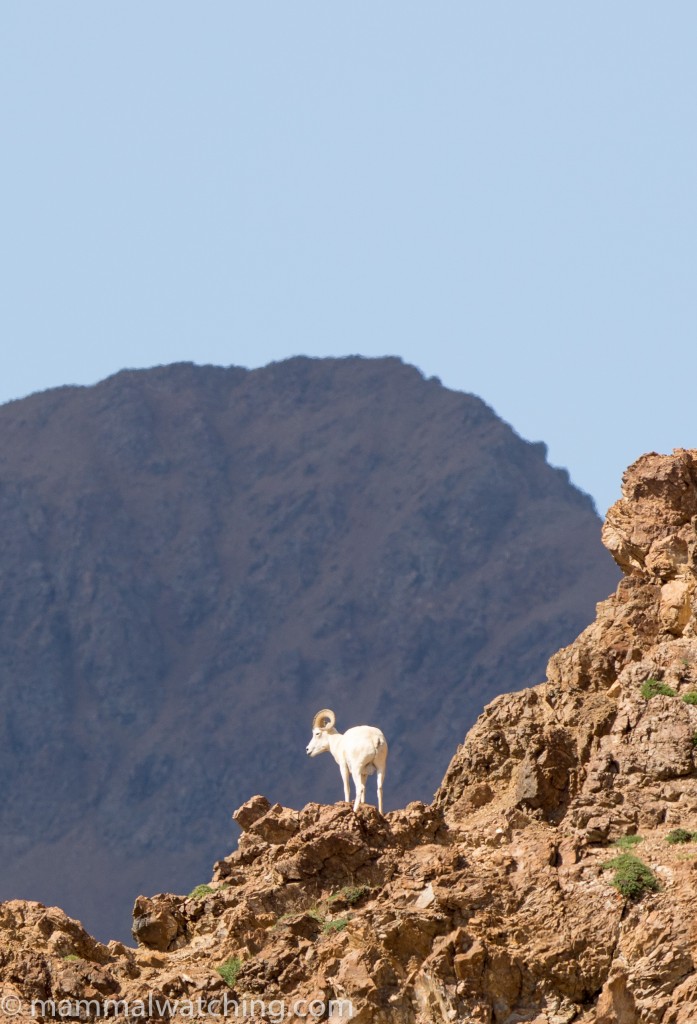
Dall’s Sheep, Ovis dalli
The bus driver stopped for 10 minutes at Polychrome Pass to indulge me in some Pika searching, but we didn’t see any.
It was frustrating having to watch wildlife from the bus, but there is precious little alternative in Denali, unless you try to win the lottery to drive the park road in either May or September.
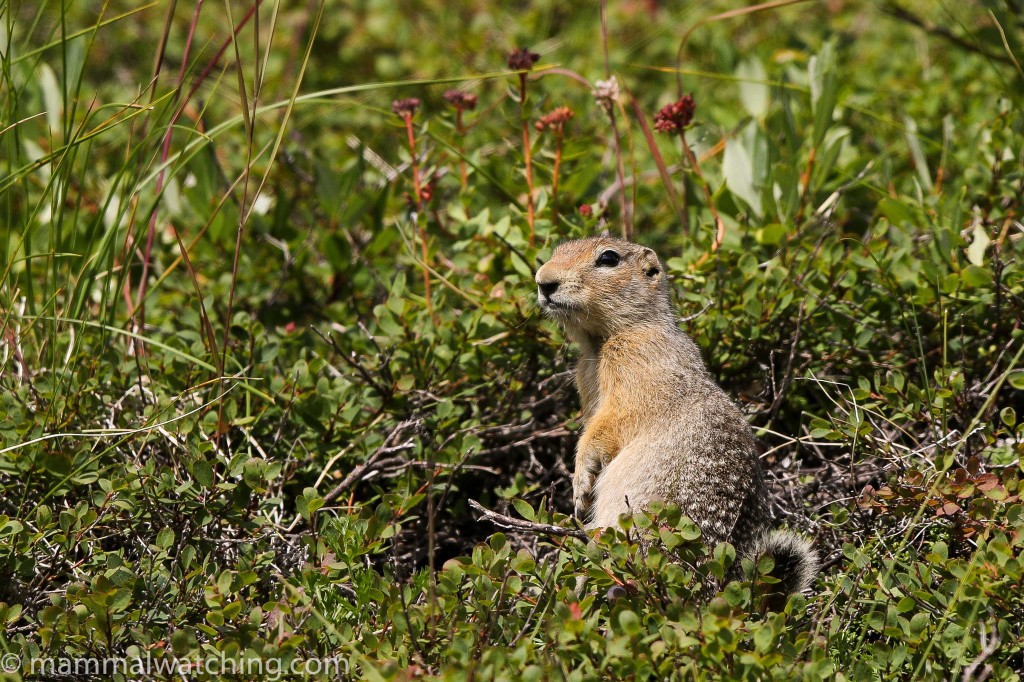
Arctic Ground Squirrel, Spermophilus parryii
We’d left the car at the visitor centre, so we could drive to the campsite late: the boreal forested stretch of road, between the gate and Teklanika, is the best habitat for Lynxes but they remain rare and will likely do so until Snowshoe Hare numbers peak again. We didn’t see a Lynx, but did see three more Moose along the road.
Hatcher Pass
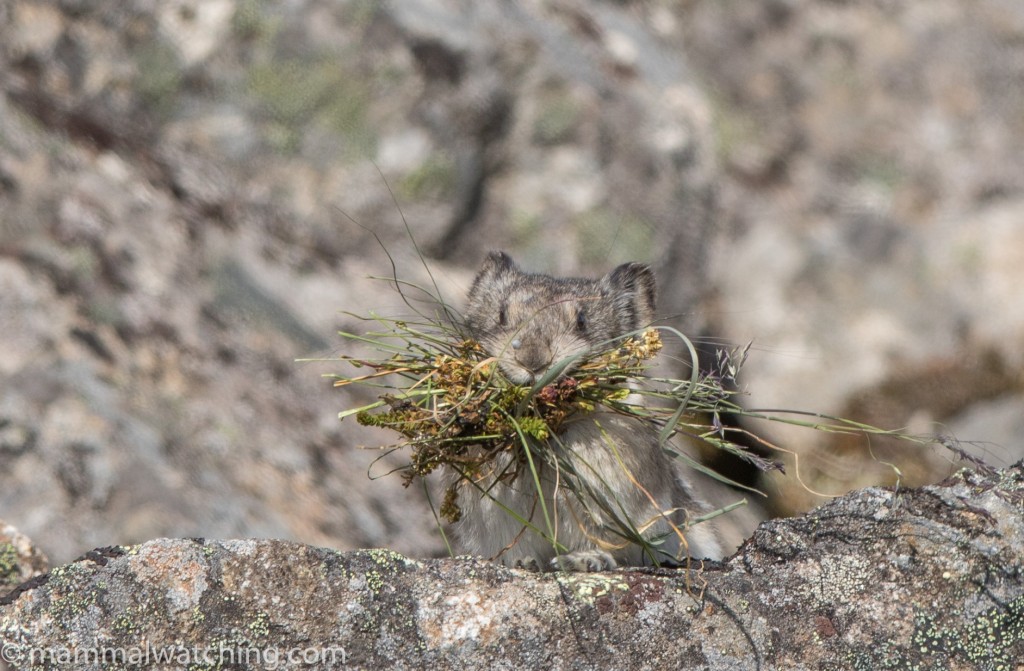
Collared Pika, Ochotona collaris
We left Denali the next morning, and drove the four hours south to Hatcher Pass, where John Fox had easily found Collared Pika in 2010. They remain easy to find, and we saw several within five minutes of arriving at the small rocky bowl just past a sign welcoming you to the Summit Lake Recreation Area (when coming from the east).
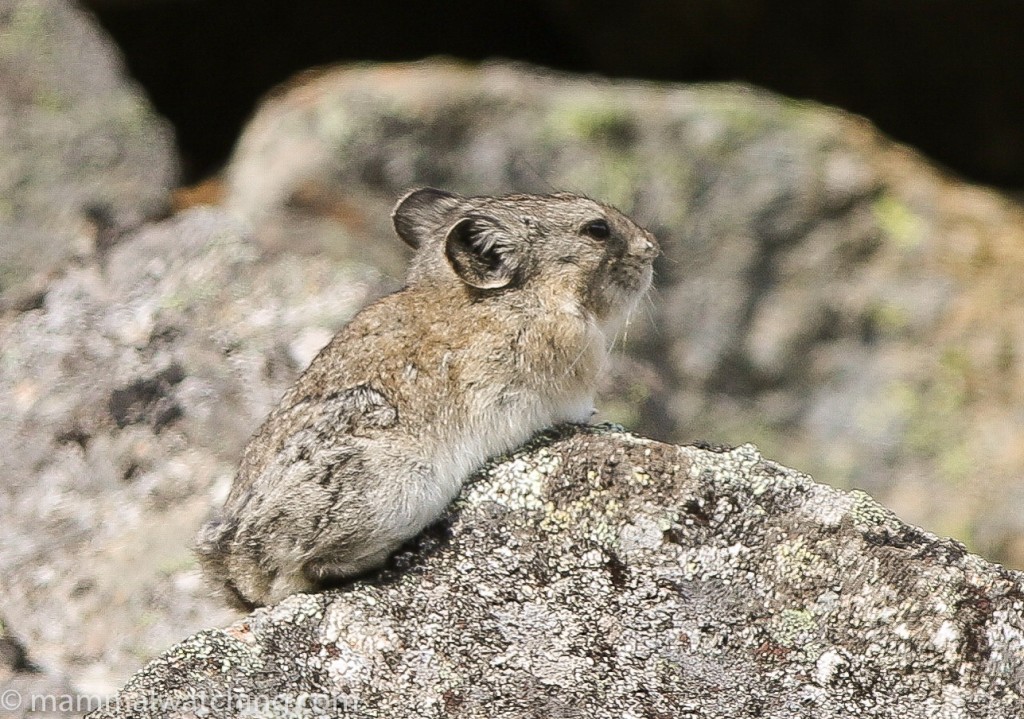
Collared Pika, Ochotona collaris
There were Hoary Marmots here too.
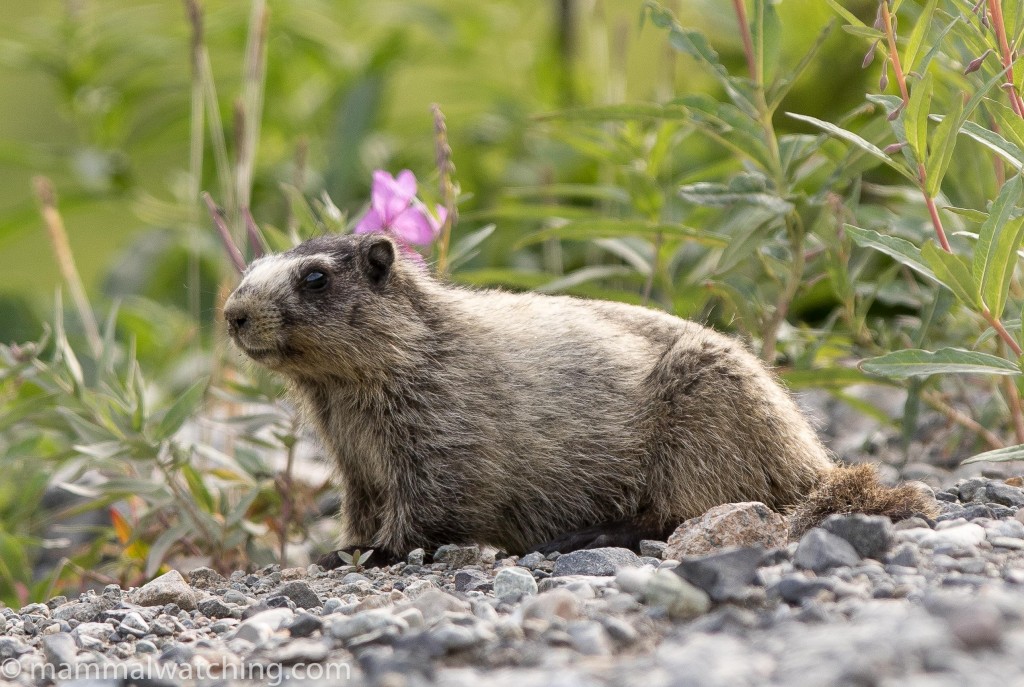
Hoary Marmot, Marmota caligata
If for some reason you dip on the pika then try the Hatcher Pass Lodge, a few minutes east of the lake. There were pikas, ground squirrels and marmots living under the chalets here and we saw several during a pleasant stay. In fact, when snow is on the ground, it might be an easier place to see the pikas than the pass, as it sounded like they scavenge for scraps around the lodge.
I set 80 sherman traps around the pass that night. But despite Vladimir Dinets’s reports of a “shrew plague” a month earlier I caught nothing, though tundra species are hard to trap.
Anchorage
The next day we stopped at Beluga Point, on the Seward Highway just out of Anchorage, twice, on either side of a high tide. There were lots of fish around, judging by the dozens of fisherman out in one creek in particular, but we only saw the back of one Beluga.
So a short visit to Alaska but a lot of fun and scenically wonderul. Definitely somewhere I would like to return, most probably during a different season.
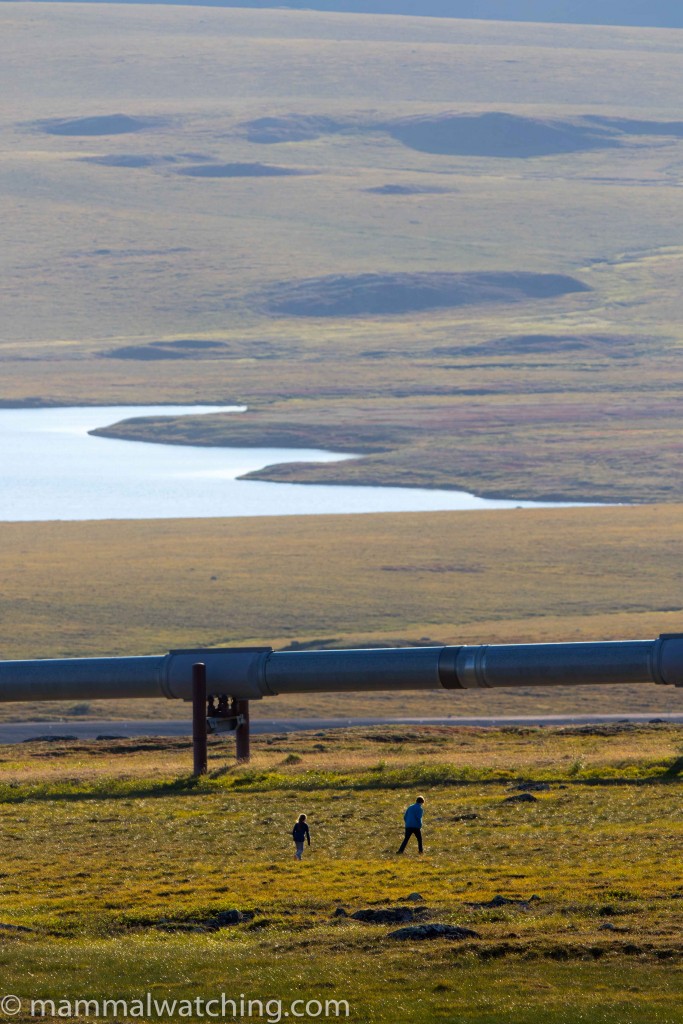
Patrick and Katy looking for marmots and avoiding bears, Brooke’s Range
Community Reports
Nome, Seward, Kenai Fjords NP & Barrow, 2024: Wise Birding, 11 days & 24 species including Polar Bear, Canada Lynx, Orca and Dall’s Porpoise.
Nome, 2024: Greg Easton, 3 days & 10 species including Musk Ox and Spotted Seal.
First trip to Alaska, 2023: Wildlife Watcher’s report featuring many of the Alaskan classic mammals and a site for Collared Pika in Denali.
Anchorage area, Nome and Barrow, April 2022: Keith Millar, 3 weeks & 22 species including Musk Ox, Largha Seal, Brown Lemming and Least Weasel.
Denali, Anchorage and Fairbanks. 2021: Charles Hood, a long weekend and 14 species including Northern Red-backed and Tundra Voles, Collared Pika and a Lynx.
Fairbanks and Denali, 2021: Bud Lensing, 6 days with plenty of mammals including Collared Pika, Moose and Lynx.
Kaktovik and Denali, September 2019: Greg Easton, 5 days with species including Polar Bears and an Ermine.
Interior Alaska Update, August 2019: Venkat Sankar, 6 days & 15 species including Musk Ox, Alaska Marmot, Canada Lynx and a Pygmy Shrew.
Outer Alaska, 2017: Vladimir Dinets, spring 2017 and many speciality species including Pribilof and St Lawrence Island Shrews, Tundra Voles, Holarctic Least Shrew and Unalaska Collared Lemmings.
Alaska, 2016: Ian Merrill, 17 days & 29 species including Polar Bear, Tundra Vole, Spotted & Northern Fur Seals and Muskox.
Barrow, 2016: Vladimir Dinets, 1 day & 9 species including Polar Bear, Ribbon Seal and 3 shrew species.
Alaska, 2014: Stefan Lithner, 3 weeks & 29 species including Largha Seal, Northern Bog and Brown Lemmings, and Water, Tundra and Dusky Shrews.
Alaska, 2010: John Fox, a few days looking for (and finding) Alaskan Marmot, Collared Pika, Caribou, Belugas and Porcupines.
Alaska, 2009: Richard Webb, two 1 week trips & 24 species including Canadian Lynx and Beluga.
Alaska, 2009: Scott Flamand, 2 weeks & 25 mammals including a Canadian Lynx, Musk Ox and Beluga.
Alaska, 1998: Richard Webb, 3 weeks & 24 mammals including Northern Fur Seals, Musk Ox and all three bear species.
Also See
RFI Collared Pika near Anchorage, August 2024
Why you should visit Brooks Camp in Katmai NP, January 2024
Advice for Alaska (RFI), December 2022
Voles and Shrews near Anchorage, May 2015)
Marmothon, 2006: Dave Robichaud’s account of seeing all 6 Marmot species in a calendar year, including Hoary and Alaska Marmots in Alaska.


Leave a Reply
You must be logged in to post a comment.